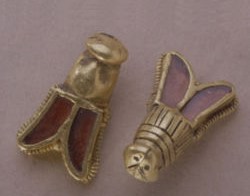I recently noticed a fresh hereditary society here in the United States, whose membership requirement is proof of descent from Merovech, the legendary founder of the Frankish royal dynasty, who would have lived in the mid fifth century if he were real: the Order of the Merovingian Dynasty.
The website states that it was “conceived of and organized” in September, 2004, by 23 founding members. Of all the various hereditary societies out there, the fact that this one exists at all belies any claimed rigor for membership.
Tucked into the website in a couple of places is a genealogical line from Charlemagne to Merovech. The path used is the one attaching Bertrada of Prüm to Theuderic III. The principal cited authority: Roderick Stuart’s Royalty for Commoners (also cited elsewhere on the site: that chestnut Holy Blood, Holy Grail).
The inconvenient truth for this particular lineage society is of course that there is no proved descent from any member of the Merovingian dynasty to any later medieval or modern person. They were subjected to the triple historical indignities of usurpation by the Carolingian Pippin, damnatio memoriae in the Carolingian accounts of that usurpation (such as Einhard’s Vita Karoli magni), and finally the broad early-medieval problem of the scarcity of written records. The result is that a large and many-branched family appears to peter out in the historical record. The most accessible careful prosopography of this family is Christian Settipani’s book, La préhistoire des Capétiens, Nouvelle histoire généalogique de l’auguste maison de France, gen. ed. Patrick Van Kerrebrouck, vol. 1 part 1 (Villeneuve d’Asq: Patrick Van Kerrebrouck, 1993). With detailed and thorough citations to both primary sources and the interpretive secondary literature, Settipani summarizes each (if not all) of the commonly claimed gateways from the Merovingian dynasty. The assertion that Bertrada, founder of the abbey of Prüm, was of Merovingian royal blood, is not implausible but it was a suggestion, first made by Maurice Chaume, based essentially on onomastics (the fact that members of her family appear to have used names also found in the royal dynasty). Merovech isn’t directly attested in contemporary literature, but is later reputed to be the father of Childeric, whose grave near Tournai, opened in the 17th century, revealed such interesting things as the enigmatic gold and cloisonné bees and the now familiar gold signet ring:


Elsewhere I’ve written on some other American lineage societies based on medieval ancestry. Of all these groups—of questionable social, genealogical, or civic value—this Merovingian group, which is a piggy-back group on the ‘Order of the Crown of Charlemagne‘, is the most self-evidently silly. For an interesting window into the world of lineage societies, I recommend perusal of the ‘Hereditary Society Community‘ website, sort of a consortium or governing council.

One Comment
Thank you for the succinct and appropriate insight into the spurious and scurrilous assertions of such rubbish. These pseudo-historical research fringe groups give the fascinating pursuit of genealogy a thoroughly negative image and should be relegated exclusively to the realm of Dungeons and Dragons.
Post a Comment